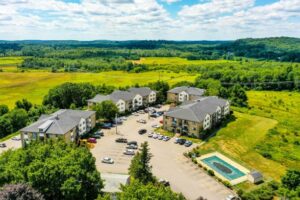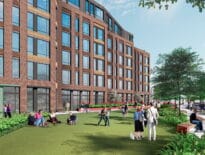
nvestor demand remains strong for suburban multifamily properties such as the 183-unit Amesbury Collection, which sold in October for $26.5 million and a cap rate of 5.2 percent. Photo courtesy of Marcus & Millichap
This year, all of us have been navigating our “new normal” by adjusting our lives to be conscious of social distancing while working from home and balancing remote learning within this ever-changing pandemic landscape.
Throughout the apartment market, landlords are adjusting to the use of virtual and self-guided tours, operating with the inability to open amenities and remaining diligent on collections. Additionally, traffic trends have been shifting as residents look for larger floorplans and outdoor space. With many employers and universities still operating remotely, residents have looked to the suburbs.
Like many of the major metro areas, the Metro Boston rental market has been a tale of two cities with the suburbs outperforming the urban markets. The urban core has been hit the hardest as renter traffic has been at its lowest and deliveries of new construction at an all-time high, while the suburbs have benefited from stronger occupancy and some rent growth throughout the COVID-19 pandemic.
Softness in Urban Luxury
From a pre-pandemic perspective, this year’s first-quarter rental market experienced 3.6 percent overall rent growth year-over-year. Over this period, the strongest trends were seen in the urban core which saw rent growth of 4.7 percent, compared to 3.3 percent in the urban infill markets and 3.5 percent in the suburbs.
During the pandemic these trends have reversed. Overall Metro Boston rents in the third quarter declined 5.8 percent year-over-year, which breaks down to a 2.9 percent drop throughout the suburbs, 5.8 percent down in the urban infill markets and 11.1 percent lower throughout the urban core. In the urban core we have seen many of the luxury high-rise communities experience even steeper rent declines and offer concessions of two to three months.
Throughout the suburbs, trends have varied with a net decline of 2.9 percent year-over-year. That said, nearly half of suburban submarkets saw rent appreciation between 0.9 percent and 4 percent. Another positive trend in the suburbs and some infill locations is that many properties are experiencing renewal rent growth and stronger retention, which has provided a positive overall trade-out.
Occupancy levels have also been stronger in the suburbs, averaging 95.9 percent compared to 93.8 percent in the urban markets. Notably, many of the luxury high-rise communities in the urban inner core have reported even lower occupancies in the 80-90 percent range.

Simon Butler
Investment Sales Trends Show Strength
What has 2020 meant for the investment sales market? While investors have had to adjust to virtual tours and travel restrictions, debt is cheaper and more capital is in the market today than in 2019.
Though the first half of 2020 brought some uncertainty in the market, the third and fourth quarters have seen some of the strongest sales trends in history. In March 2020, the Fed decreased the federal funds rate to nearly zero, which alongside spread compression, lowered interest rates to between 2.35 percent and 2.65 percent through much of the year. For 60 percent-to 70 percent–levered investors, these interest rates provided very attractive immediate cash-on-cash

Biria St. John
returns of 7 percent to 8 percent. With the strongest operational trends coming from the suburbs, core and core-plus capital has aggressively chased investment opportunities offering immediate yield.
While overall 2020 sales volume of $2.8 billion is projected to decrease 6.3 percent compared to a five-year average of $3 billion, the number of transactions increased by 7.1 percent. A significant driver to the decrease in sales volume is due to limited urban offerings and no high-rise luxury listings, which typically carry higher pricing. That said, suburban sales volume has increased 30 percent.
Because of stronger operations, pent-up capital and historically low interest rates, cap rates have compressed 25 to 50 basis points and pricing has appreciated some 15 percent.

John McLaughlin
Looking ahead, we anticipate 2021 to be a year of recovery. With unemployment continuing to trend downward and rent growth back in some submarkets, we expect fundamentals to continue to strengthen over the next year, particularly in the suburbs. As for the urban markets, we would anticipate improving trends, although we believe these communities will take longer to rebound and likely not until employers and universities are back. Additionally, with the Federal Reserve’s economic forecasts suggesting that the federal funds rate will remain near zero through at least 2023, we expect interest rates from the agencies to remain low.
Simon Butler and Biria St. John are vice chairmen and partners and John McLaughlin is a first vice president with the multi-housing investment sales team at CBRE/New England.




 |
| 

